The Featured Creatures collection provides in-depth profiles of insects, nematodes, arachnids, and other organisms relevant to Florida. These profiles are intended for the use of interested laypersons with some knowledge of biology as well as academic audiences.
Distribution
The yellowstriped armyworm, Spodoptera ornithogalli (Guenée), is common in the eastern United States as far west as the Rocky Mountains and occurs in southern Canada. However, it also is reported from southwestern states, including California. The distribution of this native insect includes Mexico, Central and South America, and many Caribbean islands. As a pest, however, its occurrence is limited principally to the southeastern states. A very similar species, western yellowstriped armyworm, Spodoptera praefica (Grote), is known only from the western states, principally California and Oregon. In California, Spodoptera praefica is much more important than Spodoptera ornithogalli.

Credit: Lyle Buss, UF/IFAS
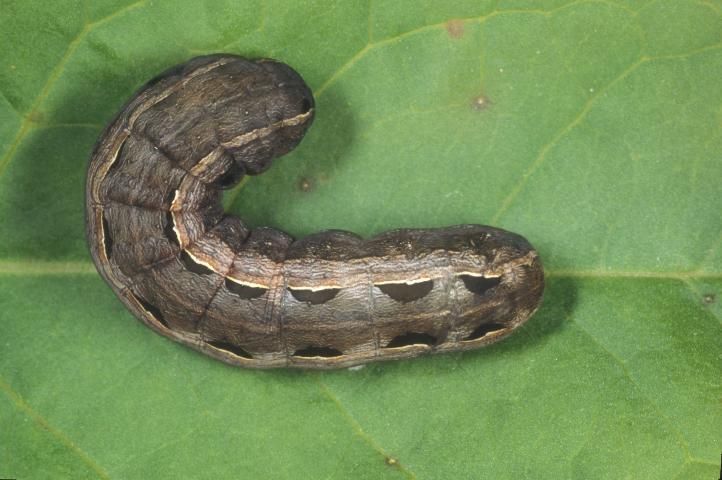
Credit: Lyle Buss, UF/IFAS
Life Cycle and Description
There seem to be three to four generations annually, with broods of adults present in March to May, May to June, July to August, and August to November. Some of the latter brood of yellowstriped armyworm overwinter as pupae, rather than emerging as adults. Although eggs, larvae, and adults of yellowstriped armyworm may be present in autumn or early winter, they cannot withstand cold weather, and perish. Development time, from egg to adult, is about 40 days.
Eggs
The eggs are greenish to pinkish brown in color and bear 45–58 small ridges. In shape, the egg is a slightly flattened sphere, measuring 0.46–0.52 mm in diameter and 0.38–0.40 mm in height. Females typically deposit clusters of 200–500 eggs, usually on the underside of leaves. Total fecundity was determined to be over 3000 eggs under laboratory conditions. The eggs are covered with scales from the body of the adults. Duration of the egg stage is three to five days at warm temperatures.
Larvae
Larvae initially are gregarious in behavior, but as they mature they disperse, sometimes spinning strands of silk upon which they are blown by the wind. There usually are six instars, although seven instars have been reported. Head capsule widths are about 0.28, 0.45, 0.8–1.0, 1.4–1.6, 2.0–2.2, and 2.8–3.0 mm, respectively, for instars one through six. The larva grows from about 2.0 to 35.0 mm (~1/8 in to1.5 in) in length over the course of development. Coloration is variable, but mature larvae tend to bear a broad brownish band dorsally, with a faint white line at the center. More pronounced are black triangular markings along each side, with a distinct yellow or white line below. A dark line runs laterally through the area of the spiracles, and below this is a pink or orange band. The head bears a light-colored inverted V on the face.
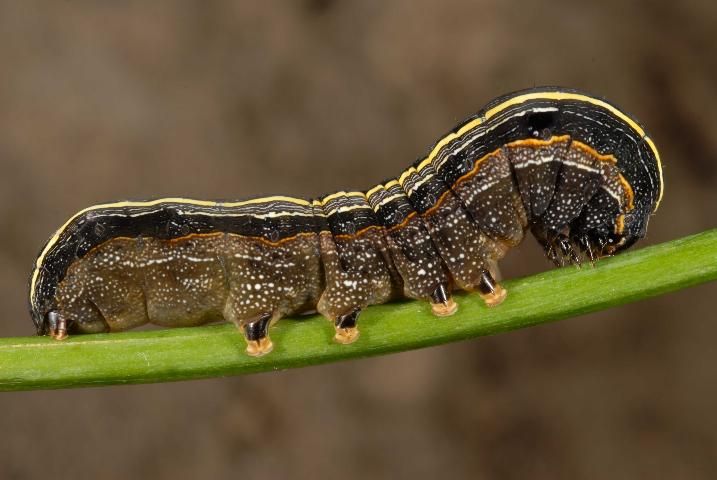
Credit: Lyle Buss, UF/IFAS
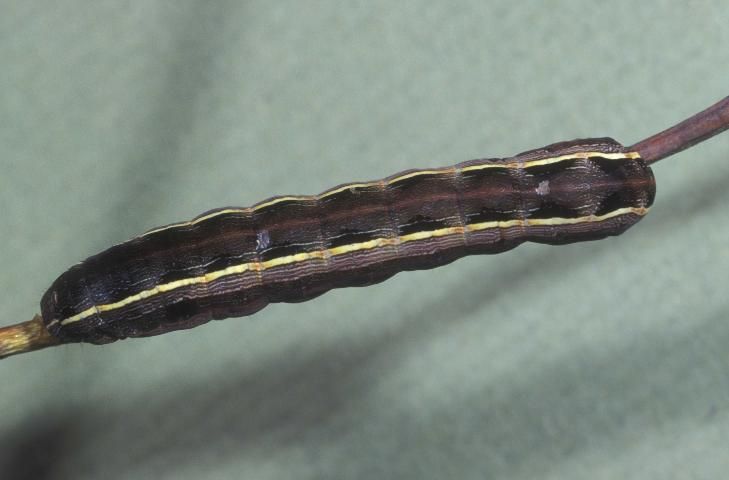
Credit: Paul Choate, UF/IFAS
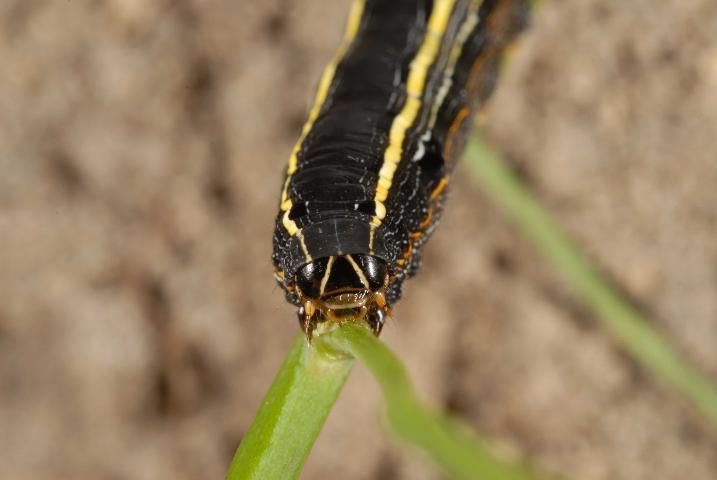
Credit: Lyle Buss, UF/IFAS
Dark subdorsal spots are found on the mesothorax of yellowstriped armyworm, and the triangular shape of these spots aids in distinguishing this insect from sweetpotato armyworm, Spodoptera dolichos, and velvet armyworm, Spodoptera latifascia, in eastern states. The head is brown but has extensive blackish markings. Duration of the larval stage is 14–20 days, with the first three instars requiring about two days each and the last three instars requiring about three days each.
Pupae
Larvae pupate in the soil within a cell containing a thin lining of silk. The reddish brown pupa measures about 18 mm (~3/4 in) in length. Duration of the pupal stage is 9–22 days, normally averaging 12–18 days.
Adults
The moths measure 34–41 mm (~ 1.5–1.75 in) in wing span. The front wings are brownish gray with a complicated pattern of light and dark markings. Irregular whitish bands normally occur diagonally near the center of the wings, with additional white coloration distally near the margin. The hind wings are opalescent white, with a narrow brown margin. Under laboratory conditions, average longevity of adults is 17 days, with most egg production completed by the tenth day (Adler et al. 1991).
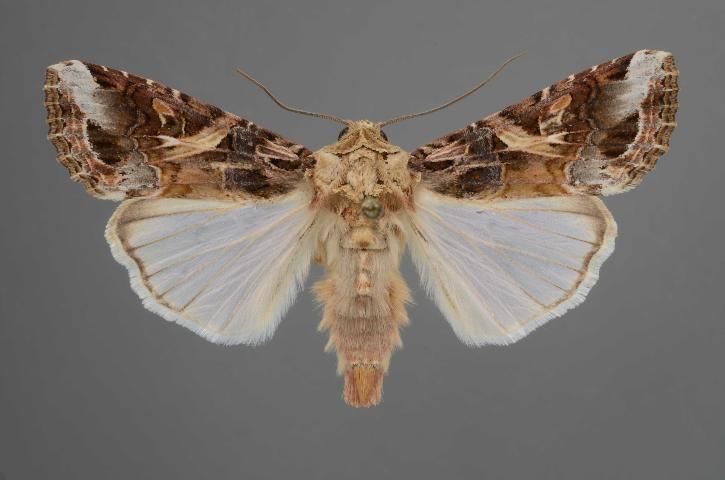
Credit: Lyle Buss, UF/IFAS
The most complete description of Spodoptera ornithogalli and its biology is given by Crumb (1929), with additional comments by Crumb (1956). Keys for identification are also found in these references. Keys for separation of Spodoptera adults can be found in Todd and Poole (1980) and Heppner (1998). Larvae can be distinguished using the keys of Passoa (1991) and Heppner (1998).
Damage
Larvae damage plants principally by consumption of foliage. The small, gregarious larvae tend to skeletonize foliage but as the larvae grow and disperse, they consume irregular patches of foliage or entire leaves. However, they will also feed on the fruits of tomato, cotton, and other plants. Larval consumption of soybean was estimated by King (1981) to total 115 sq cm (~18 sq in); this is an intermediate value relative to some other lepidopterous defoliators.
Host Plants
This is a general feeder, reportedly damaging many crops. Among vegetable crops injured are asparagus, bean, beet, cabbage, cantaloupe, carrot, corn, cucumber, lettuce, onion, pea, potato, rhubarb, rutabaga, salsify, sweet potato, tomato, turnip, and watermelon. Other crops damaged include alfalfa, blackberry, cotton, clover, grape, lentil, peach, rape, raspberry, sorghum, soybean, sugarbeet, sweetclover, sunflower, tobacco, wheat, and several flower crops. Some of the weed species known to be suitable hosts are castorbean, Ricinus communis; dock, Rumex sp.; gumweed, Grindelia sp.; horse nettle, Solanum carolinense; horseweed, Erigeron canadensis; jimsonweed, Datura sp.; lambsquarters, Chenopodium album; morning glory, Ipomoea sp.; plantain, Plantago lanceolata; prickly lettuce, Lactuca scariola; and redroot pigweed, Amaranthus retroflexus. In many cases, yellowstriped armyworm develops first on weed or rangeland plants, with subsequent generations affecting crops.
Natural Enemies
Several wasp parasitoids affect Spodoptera ornithogalli, including Rogas laphygmae Viereck, R. terminalis (Cresson), Zele mellea (Cresson), Chelonus insularis Cresson, and Apanteles griffini Viereck (all Hymenoptera: Braconidae). Also, Euplectrus plathypenae Howard (Hymenoptera: Eulophidae) attacks larvae and causes a cessation of feeding within two days (Parkman and Shepard 1981). Thus, this parasitoid is particularly valuable at minimizing damage.
Numerous flies have been found to parasitize yellowstriped armyworm including Archytas spp., Choeteprosopa hedemanni Brauer and Bergenstamm, Euphorocera omissa (Reinhard), E. tachinomoides Townsend, Lespesia aletiae (Riley), L. archippivora (Riley), Omotoma fumiferanae (Tothill), Winthemia quadripustulata (Fabricius), and W. rufopicta (Bigot) (all Diptera: Tachinidae).
A nuclear polyhedrosis virus is highly pathogenic to larvae, and survivors that do not succumb exhibit reduced fecundity (Hostetter et al. 1990; Young 1990).
Undoubtedly, predators are important, but their effect has not been quantified in the related western yellowstriped armyworm. Bisabri-Ershadi and Ehler (1981) reported that over 96% of total mortality occurred in the egg and early larval stages, and most was attributed to predation. The most important predators were minute pirate bugs, Orius tristicolor (White) (Hemiptera: Anthocoridae); bigeyed bugs, Geocoris spp. (Hemiptera: Lygaeidae); and damsel bugs, Nabis spp. (Hemiptera: Nabidae). The legume bug, Lygus hesperus Knight (Hemiptera: Miridae), was a facultative predator, often feeding on armyworm eggs. These, or similar, predators undoubtedly affect yellowstriped armyworm.
Management
Insecticides
Insecticides are applied to foliage to prevent injury by larvae. The microbial insecticide Bacillus thuringiensis can be applied to kill armyworms, but should be applied when the larvae are young, as they become difficult to control as they mature. Larvae will consume bran bait containing insecticide.
For more information see the following:
Cultural Methods
Proximity of crops to rangeland containing weed hosts, or to alfalfa, may be important factors predisposing vegetable crops to injury. At high densities, especially if alfalfa hay is mowed, larvae will sometimes disperse simultaneously and invade nearby vegetable fields. Physical barriers such as trenches can be used to deter such dispersal.
Selected References
Adler, P.H. and C.R.L. Adler. 1988. Behavioral time budget for larvae of Heliothis zea (Lepidoptera: Noctuidae) on artificial diet. Annals of the Entomological Society of America 81:682–688. https://doi.org/10.1093/aesa/81.4.682
Adler, P.H., M.B. Willey, and M.R. Bowen. 1991. Temporal oviposition patterns of Heliothis zea and Spodoptera ornithogalli. Entomol. Experimentalis et Applicata 58:159–164. https://doi.org/10.1111/j.1570-7458.1991.tb01463.x
Bisabri-Ershadi, B. and L.E. Ehler. 1981. Natural biological control of western yellow-striped armyworm, Spodoptera praefica (Grote), in hay alfalfa in northern California. Hilgardia 49:1–23. https://doi.org/10.3733/hilg.v49n05p023
Capinera, J.L. 2001. Handbook of Vegetable Pests. Academic Press, San Diego. 729 pp.
Crumb, S.E. 1929. Tobacco cutworms. USDA Technical Bulletin 88. 179 pp.
Crumb, S.E. 1956. The larvae of the Phalaenidae. USDA Technical Bulletin 1135. 356 pp.
Heppner, J.B. 1998. Spodoptera armyworms in Florida (Lepidoptera: Noctuidae). Florida Department of Agriculture and Consumer Service, Division of Plant Industry. Entomolmology Circular 390. 5 pp.
Hostetter, D.L., B. Puttler, A.H. McIntosh, and R.E. Pinnell. 1990. A nuclear polyhedrosis virus of the yellowstriped armyworm (Lepidoptera: Noctuidae). Environmental Entomology 19:1150–1154. https://doi.org/10.1093/ee/19.4.1150
King, E.W. 1981. Rates of feeding by four lepidopterous defoliators of soybeans. Journal of the Georgia Entomological Society 16:283–288.
Parkman, P. and M. Shepard. 1981. Foliage consumption by yellowstriped armyworm larvae after parasitization by Euplectrus plathypenae. Florida Entomologist 64:192–194. https://doi.org/10.2307/3494612
Passoa, S. 1991. Color identification of economically important Spodoptera larvae in Honduras (Lepidoptera: Noctuidae). Insecta Mun. 5:185–196.
Todd, E.L. and R.W. Poole. 1980. Keys and illustrations for the armyworm moths of the noctuid genus Spodoptera Guenée from the Western Hemisphere. Annals of the Entomological Society of America 73:722–738. https://doi.org/10.1093/aesa/73.6.722
Young, S.Y. 1990. Effect of nuclear polyhedrosis virus infection in Spodoptera ornithogalli larvae on post larval stages and dissemination by adults. Journal of Invertebrate Pathology 55:69–75. https://doi.org/10.1016/0022-2011(90)90034-4